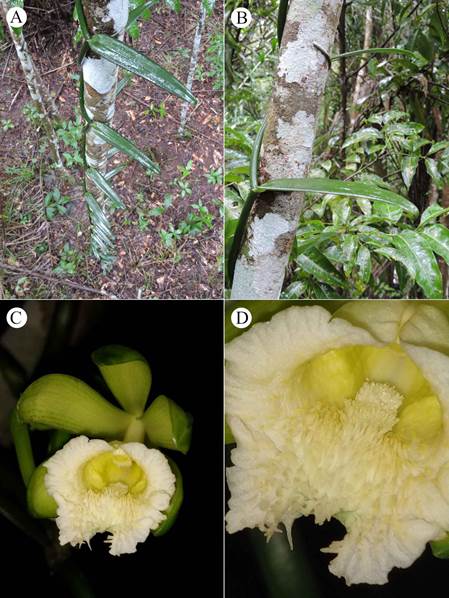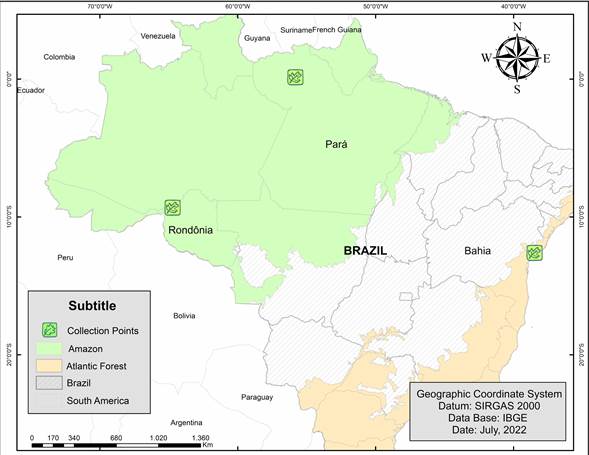Introduction
Vanilla Plum. ex Mill. is certainly one of the well-known genera of the family Orchidaceae due to the ornamental, medicinal and culinary attributes of some of its taxa (Bythrow, 2005). Recent concerns regarding the narrow genetic diversity of Vanilla species have led to the mapping of natural populations and determination of conservation priorities (Bory et al., 2008; Andriamihaja et al., 2020; Chambers et al., 2021). These studies have provided a better understanding of the alpha taxonomy (Karremans et al., 2020; Chiron et al., 2021), pollination strategies and mechanisms (Pansarin, 2022; Watteyn et al., 2023), seed dispersal systems (Pansarin, 2021; Pansarin and Suetsugu, 2022), spatial distribution patterns of populations (Barberena et al., 2021), and they have expanded our knowledge of the geographic range size of many species (e.g., Krahl et al., 2020; Engels and Koch, 2021) and yielded the description of new ones (e.g., Damian and Mitidieri, 2020; Damian et al., 2022).
Vanilla is a pantropical genus with about 120 species mostly found in the Neotropics, especially in Brazil (Karremans et al., 2020). During field studies in the metropolitan region of Salvador in the state of Bahía, Brazil, we found a population of Vanilla karenchristianae Karremans & P. Lehm., a recently described species whose distribution and circumscription are progressively becoming better understood (Karremans and Lehmann, 2018; Karremans et al., 2020; Chiron et al., 2021; Flanagan et al., 2022). Here, we report for the first time the occurrence of the species in the Atlantic Forest and in the Northeast region of Brazil and briefly discuss its taxonomic and ecological aspects.
Material and Methods
We present a description of V. karenchristianae based on the analysis of the newly found population and complemented with information on materials collected in other sites in Brazil and deposited in herbaria. The specimens were photographed in situ with a Motorola Moto Z3 cell phone (Motorola Mobility LLC, Chicago, USA) and a Nikon Coolpix P600 camera (Nikon Corporation, Tokyo, Japan). A voucher was collected and deposited in the ALCB herbarium (acronym according to Thiers, 2023). The Global Biodiversity Information Facility (GBIF, 2023), REFLORA Virtual Herbarium (REFLORA, 2023), and Environmental Information Reference Center (CRIA, 2023) databases were checked in order to locate other material of V. karenchristianae and its synonyms. Physical specimens of V. karenchristianae deposited in the MG herbarium and photographs of the vouchers from the herbaria CEN, INPA, and RB were examined (acronyms according to Thiers, 2023). A distribution map of V. karenchristianae in Brazil was created using the ARC-GIS software v. 10.7.1 (ESRI, 2019).
Results
Taxonomy
Vanilla karenchristianaeKarremans & P. Lehm., Orchids (West Palm Beach) 87(4): 305-307. 2018. Fig. 1.

Figure 1: Vanilla karenchristianae Karremans & P. Lehm. A. habit; B. leaf details; C. flower; D. lip details, highlighting the penicillate callus (F.F.V.A. Barberena et al. 421 - ALCB). Photographs by Felipe Fajardo Villela Antolin Barberena (A-B) and Messandro dos Santos Domitilo da Costa (C-D).
TYPE: COSTA RICA. Puntarenas, Corredores, Canoas, 27.IX.2017, A. P. Karremans et al. 8087 (holotype: USJ, isotypes: CR, JBL-spirit).
Secondary hemiepiphytic, climbing herb with monopodial growth; stems not thickened in pseudobulbs, subcylindrical, grooved, internodes 7.1-12 cm long; leaves 10-14.1 × 1.8-2.6 cm, dark green, sessile, distributed along the stem, coriaceous, ensiform, margin entire, slightly revolute, apex uncinate; inflorescence ca. 4.8 cm long, racemose, axillary, bearing up to 25 flowers over time, opening singly in succession; floral bracts ca. 0.5 cm long; flowers resupinate; pedicellate ovary 3.3-4.2 cm long; sepals and petals greenish, margin entire, dorsal sepal 3.3-4.7 × 0.7-0.9 cm, oblanceolate, apex acute, lateral sepals 3.3-4.6 × 1.1-1.4 cm, obliquely oblanceolate, apex acute, petals 3.1-4.7 × 0.6-0.85 cm, obliquely oblong to slightly oblanceolate, with a very conspicuous, elevated dorsal keel; lip 3.1-4.7 × 2.6-3.3 cm, white, obscurely trilobed, obovate in outline, with noticeably several longitudinal veins and papillose-verruculose keels, longer towards the apex, margin irregularly crenate, slightly revolute, apex emarginate, penicillate callus 0.8-1 × 0.5-0.6 cm, oblong, closer to the apex than the base, with flabellate, densely lacerate-laciniate scales; column 2.5-3 × 0.5-0.6 cm, ventrally densely pubescent; anther cap and pollen not seen; capsules ca. 9.2 × 1.4 cm, green, oblongoid.
Examined material: BRAZIL. Bahía, Candeias, BR-324, km 582, sentido Feira de Santana, 39 m, 12°36'36''S, 38°29'02''W, 20.VII.2022, fl, fr, F. F. V. A. Barberena 421 (ALCB). Pará, Óbidos, entre Santo Antônio e Solidão, fl, 14.IX.1927, A. Ducke s.n. (RB 19446). Rondônia, Porto Velho, Cachoeira de Jirau, 85 m, 9°19'37''S, 64°43'35''W, 22.III.2010, fl. cult. X.2011, G. Pereira-Silva et al. 15128 (CEN). (Acre or Amazonas), Rio Purús, (3.V.1904), fl. cult. VIII.1906, J. Huber s.n. (MG 007302).
Discussion
Vanilla karenchristianae belongs to the V. planifolia group (sensuSoto Arenas and Cribb, 2010). Chiron et al. (2021) treated V. karenchristianae as a synonym of Vanilla ensifolia Rolfe, claiming that the morphological differences between them were unclear and could represent intraspecific variability. Nonetheless, Rolfe (1892) described V. ensifolia from dried specimens and stated that he analyzed only one flower, with the “imperfect” lip, and he did not provide details about the disc and the crest. Furthermore, material of V. ensifolia is restricted to the type specimens (K000463744 and P00367037), making it impossible to obtain additional floral details. We agree with previous authors (Karremans et al., 2020; Flanagan et al., 2022) that V. karenchristianae is a distinct species, easily recognized from other Vanilla species by a set of characteristics, namely: the very narrow leaves with a recurved apex, green sepals and petals, carinate petals, white lip with crenate margin (not fimbriate), dense tuft of appendages on the lip, white callus, and ventrally densely pubescent column (Fig. 2). The Brazilian Vanilla uncinata Huber ex Hoehne (Hoehne, 1937; 1945), an invalid name historically treated as synonym of Vanilla odorata C. Presl (Garay, 1978; Soto Arenas and Cribb, 2010), was recognized as a synonym of V. karenchristianae (Karremans et al., 2020).

Figure 2: Distribution of Vanilla karenchristianae Karremans & P. Lehm. in Brazil. Map prepared by João Victor Paixão de Sousa Ferreira.
Vanilla karenchristianae is currently known to occur in Nicaragua, Costa Rica, Colombia, Peru and Brazil at elevations from 30 to 1100 m a. s. l. (Karremans et al., 2020; Flanagan et al., 2022). In Brazil, there are only four records of this species, including the one added here. Previous records consist of specimens collected in the Amazon phytogeographic domain, in the municipalities of Óbidos (state of Pará) and Porto Velho (state of Rondônia), and an uncertain locality along the Púrus River (in the state of Amazonas or Acre; not represented in the Fig. 2). In the state of Pará, the species was found in terra firme forest. We revised a specimen from Manaus (Cabral and Dávila 1866 - INPA 284427), state of Amazonas, previously identified as V. uncinata and concluded it corresponds to Vanilla labellopapillata A.K. Koch, Fraga, J.U. Santos & Ilk.-Borg. (Koch et al., 2013) instead, a relatively common species in the region, as pointed out by Krahl et al. (2020).
We found ten individuals of V. karenchristianae growing on trees very close to a marshy area in a particular rural property of one of the authors (MSDC) in the municipality Candeias in the metropolitan region of Salvador, state of Bahía. The locality is nearby the federal highway BR-324, on the stretch that connects the municipalities of Salvador and Feira de Santana, both in the state of Bahía. Specimens were found growing at about 40 m elevation. Flowers and fruits of V. karenchristianae have been seen in July at this site. The vegetation at the collection site consists of an Atlantic Forest fragment that has been regenerating for 23 years. In the surroundings, there are only sparse forest fragments within unfavorable matrices that are not legally protected, which gives an idea of the threats to which the species may be locally exposed.
Our discovery is also relevant from a biogeographic point of view. The present record represents the most eastern distribution of V. karenchristianae and is located approximately 2380 km away from the nearest locality where the species has been recorded (Óbidos, Pará). This distance is greater than the territorial extension of Central America and five-fold greater than the territorial extension of Costa Rica. We thus reinforce that V. karenchristianae is an infrequent species with a wide geographic distribution like most species of the genus, as proposed by Karremans et al. (2020), and is not a locally restricted and highly threatened species on a global scale, as initially thought (Karremans and Lehmann, 2018).
However, as many other Vanilla species (Flanagan and Mosquera-Espinosa, 2016), V. karenchristianae forms small populations and seems to occur mainly in humid forests. In Brazil, it is currently known only from the Amazon and Atlantic Forest phytogeographic domains and has been recorded from just four localities. Further recording efforts are necessary to fully understand the geographical distribution and ecological requirements of V. karenchristianae.











 nova página do texto(beta)
nova página do texto(beta)



